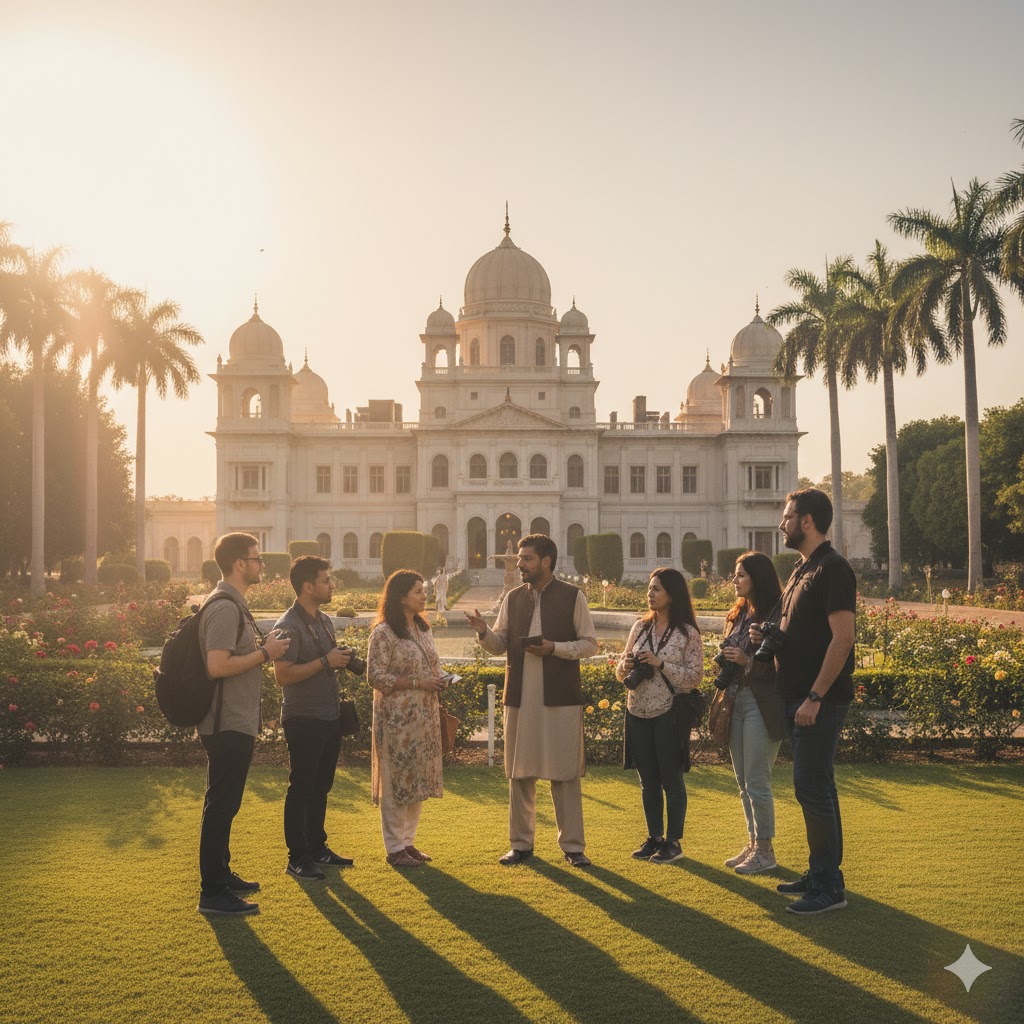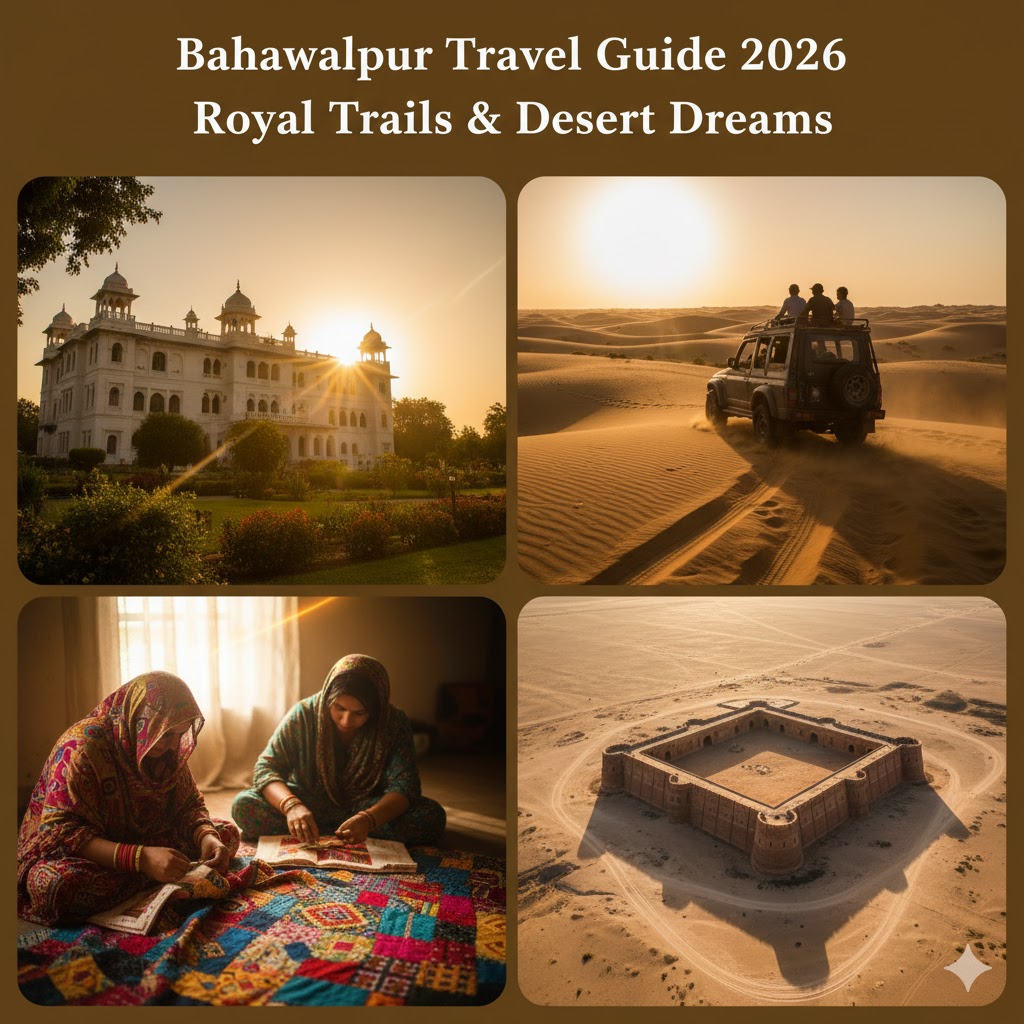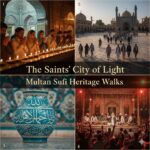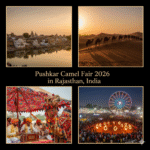1. Introduction — The Desert Jewel of Punjab
Bahawalpur Travel Guide 2026, Once a princely state that rivaled the grandeur of Hyderabad Deccan and Jaipur, Bahawalpur remains a city where royalty whispers through its sand dunes and Mughal-inspired palaces. Founded in 1748 by Nawab Bahawal Khan Abbasi, this southern Punjab gem blends regal architecture, Sufi spirituality, and desert wilderness in one breathtaking destination.
From the Darbar Mahal’s red sandstone façade to the Cholistan Desert’s golden dunes, Bahawalpur offers travelers a rare fusion of culture, luxury, and adventure — a serene contrast to the bustle of Lahore or Karachi.
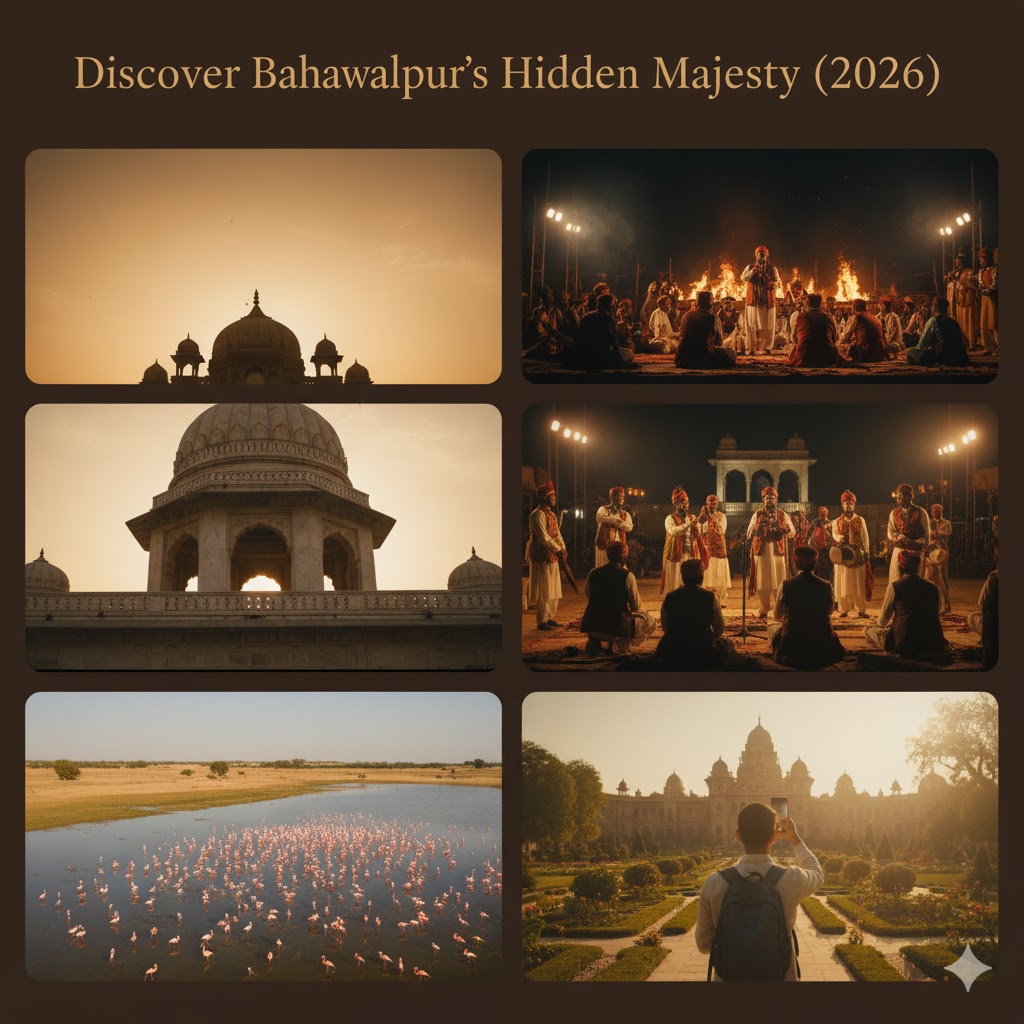
2. Getting There — The Gateway to Southern Punjab
Bahawalpur is easily accessible by air, rail, and road. Bahawalpur Airport (BHV) connects the city with Islamabad, Karachi, and Lahore. Travelers from Multan can reach Bahawalpur in under two hours via the M-5 Motorway, while overnight trains such as the Karachi Express and Awam Express offer scenic rides across the Indus plains.
Traveler’s Tip: For a cultural road trip, drive from Multan to Bahawalpur, stopping at Ahmedpur East for traditional pottery and mango orchards.
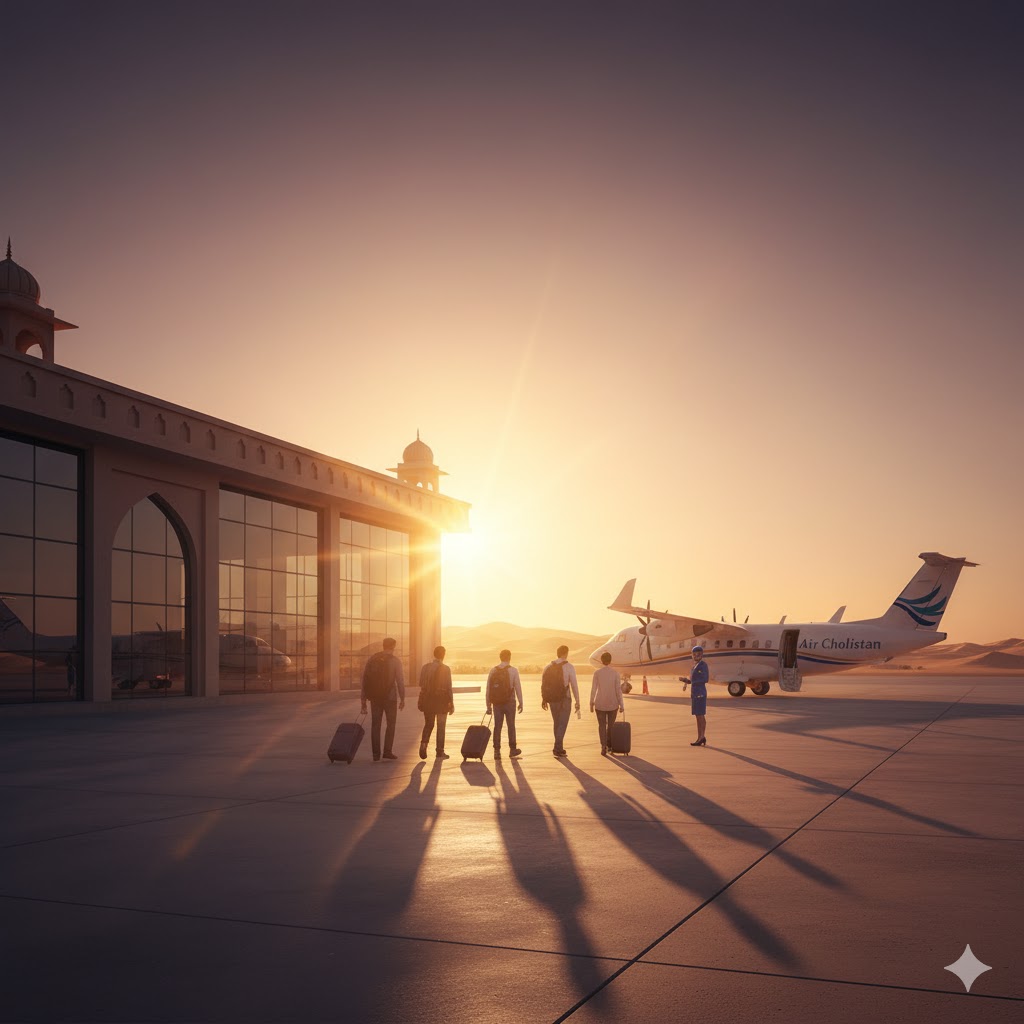
3. Best Time to Visit Bahawalpur
The ideal time to visit is November to March, when the desert breeze is gentle and the royal gardens bloom. Avoid the scorching summer months (May–July), when temperatures can exceed 45°C.
The winter season also coincides with Cholistan Jeep Rally and Sufi music festivals, offering perfect timing for cultural immersion.
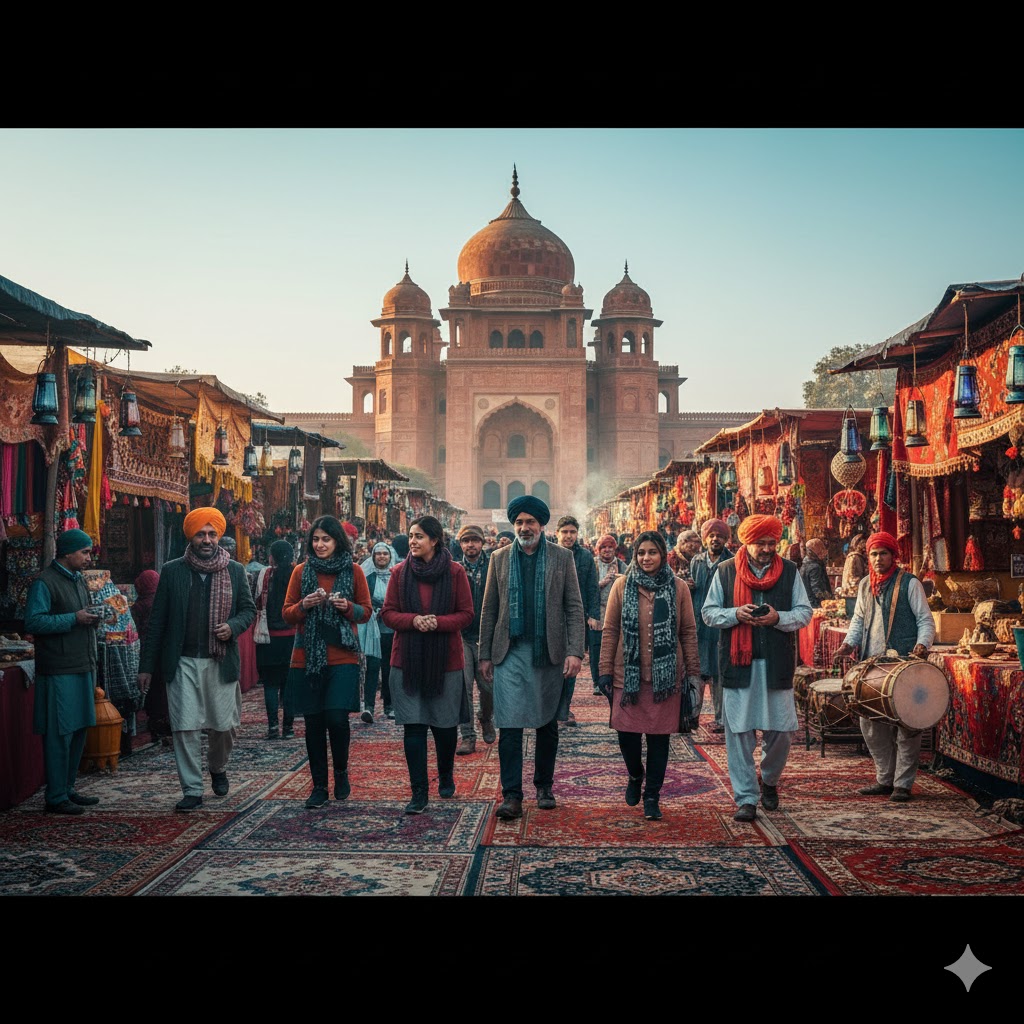
4. Top Attractions in Bahawalpur
4.1 Noor Mahal — The Crown Jewel of Bahawalpur
Inspired by Italian and Corinthian styles, Noor Mahal stands as a symbol of Bahawalpur’s Nawabi grandeur. Completed in 1875, it boasts 32 rooms adorned with imported chandeliers, Italian marble, and royal portraits.
At sunset, the palace’s creamy façade glows amber, surrounded by well-manicured lawns where peacocks roam freely. Today, it’s managed by the Pakistan Army and occasionally hosts cultural receptions.
Traveler’s Tip: Visit in the evening when the palace illuminates; tickets cost approximately PKR 200 for locals and PKR 400 for foreigners.
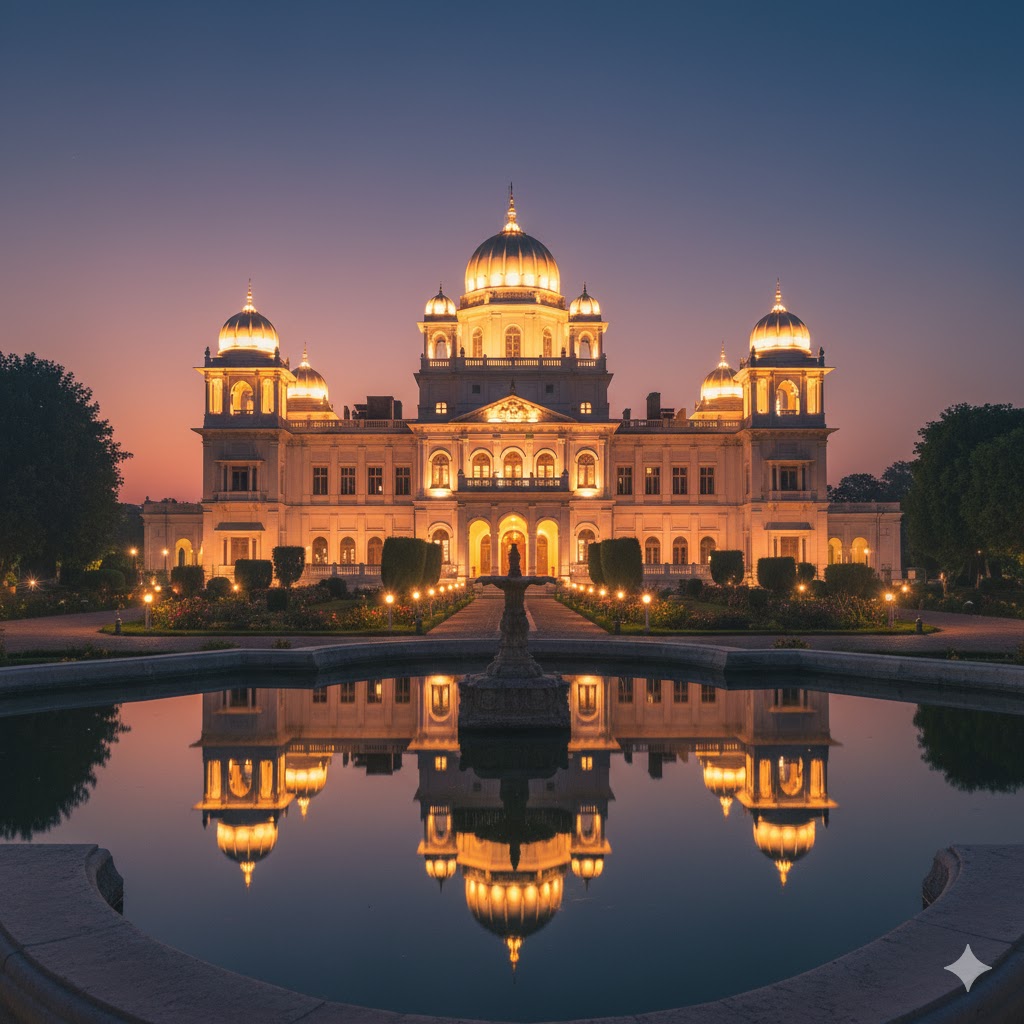
4.2 Darbar Mahal — The Nawabi Legacy
Darbar Mahal, with its red sandstone arches and domed towers, represents the true essence of Bahawalpur’s regal past. Built by Nawab Bahawal Khan V in 1905, the palace served as the royal court for official ceremonies.
The interiors echo with Mughal and Rajput influences — carved jharokas, floral frescoes, and intricately patterned ceilings. Though access inside is restricted due to military management, visitors can photograph the exteriors and stroll around its gardens.
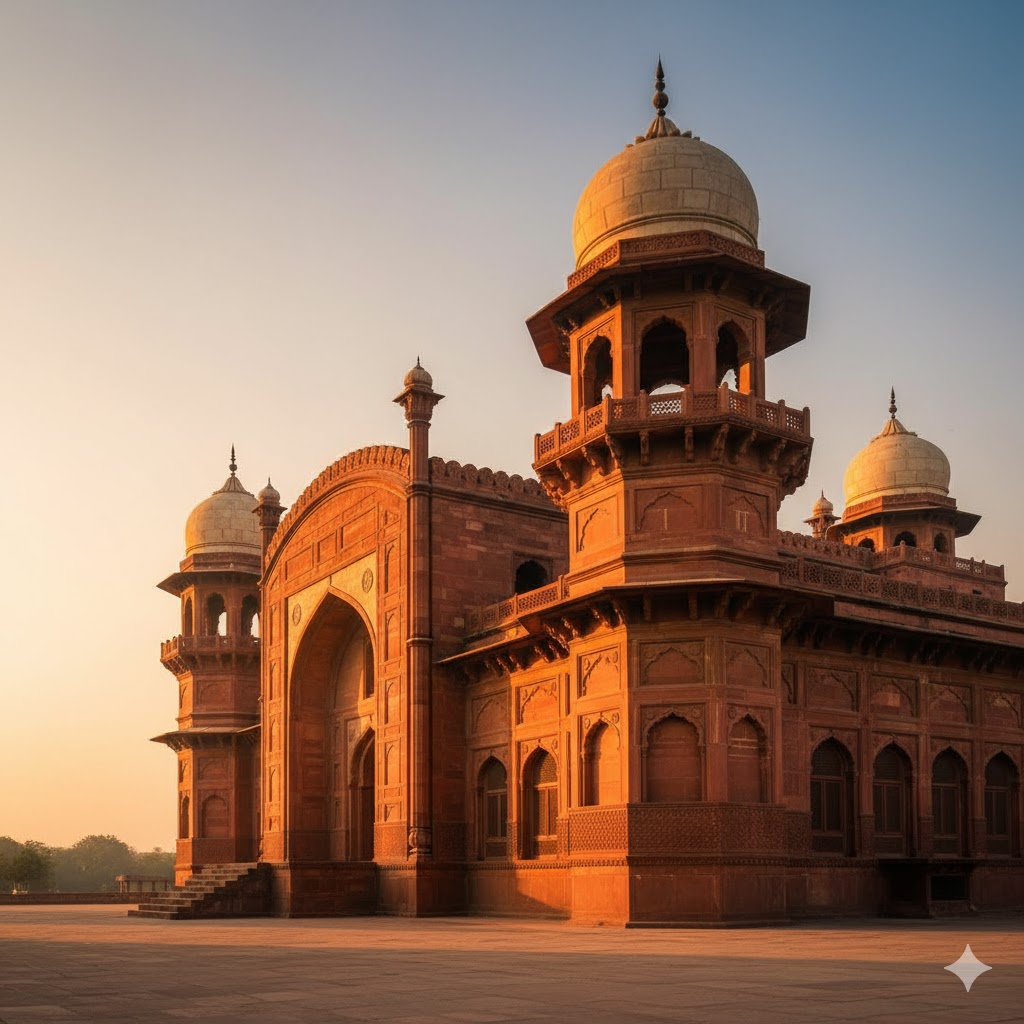
4.3 Derawar Fort — The Desert Fortress of Cholistan
A true wonder of Pakistan’s desert architecture, Derawar Fort dominates the Cholistan Desert, about 100 km from Bahawalpur. Its 40 massive bastions stretch in a perfect square, visible for miles across the dunes. Originally built by a Rajput ruler in the 9th century and later captured by the Abbasi Nawabs, it remains one of the region’s most photogenic sites.
Travelers often combine a visit with camel rides and overnight stays in desert camps, where starlit skies reveal the unfiltered beauty of Cholistan.
Local Tip: Hire a 4×4 or join TDCP’s guided Cholistan Desert Safari. Carry plenty of water and sun protection.
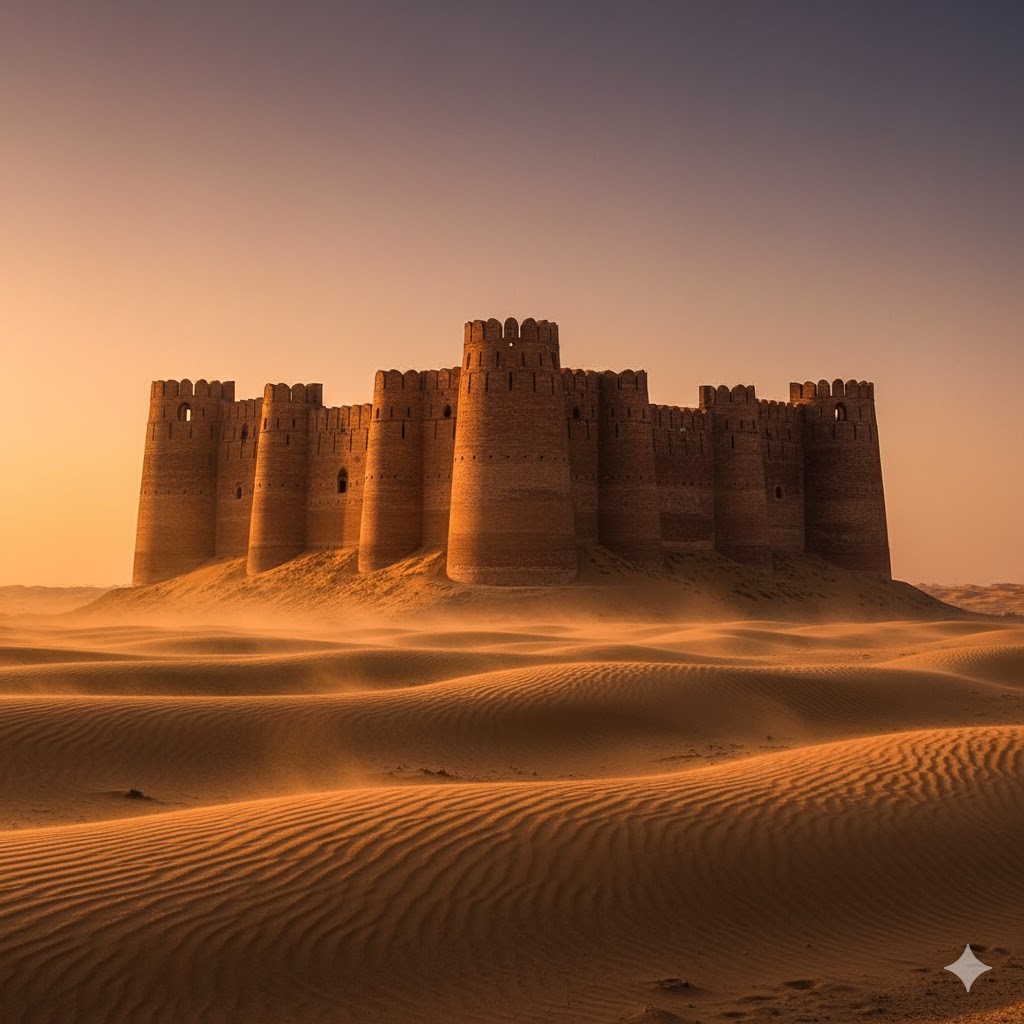
4.4 Abbasi Mosque — The Marble Jewel of Derawar
Just beside Derawar Fort lies the Abbasi Mosque, a pristine white marble structure modeled after Delhi’s Jama Masjid. Built by Nawab Bahawal Khan in the 19th century, its domes shimmer under the desert sun, creating a striking contrast against the ochre landscape.
It serves as both a spiritual center and a rest stop for travelers exploring Cholistan.
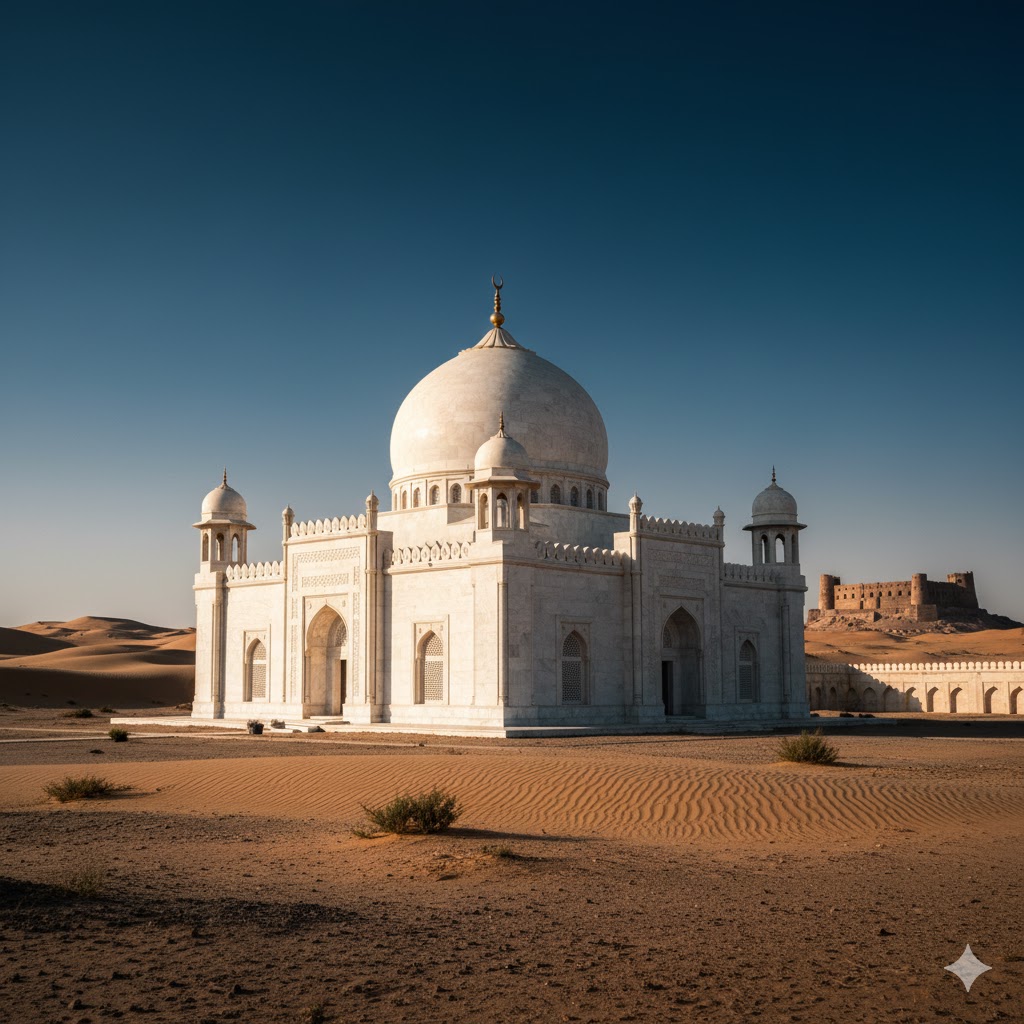
4.5 Lal Suhanra National Park — The Desert’s Green Heart
Located just 36 km east of Bahawalpur, Lal Suhanra National Park is a rare ecological wonder — where desert, forest, and wetland ecosystems coexist harmoniously. Covering over 162,000 acres, it’s one of Asia’s largest national parks and a paradise for nature enthusiasts.
Home to blackbucks, chinkara deer, blue bulls, and migratory birds, the park was established in 1972 to preserve the Cholistan ecosystem. The park also houses a dedicated breeding center for the endangered blackbuck, once native to this region.
Traveler’s Tip: Visit around sunrise or sunset for birdwatching; the best time to spot blackbucks is between December and February. You can book eco-lodges or tents through the Forest Department Bahawalpur Office for overnight stays.
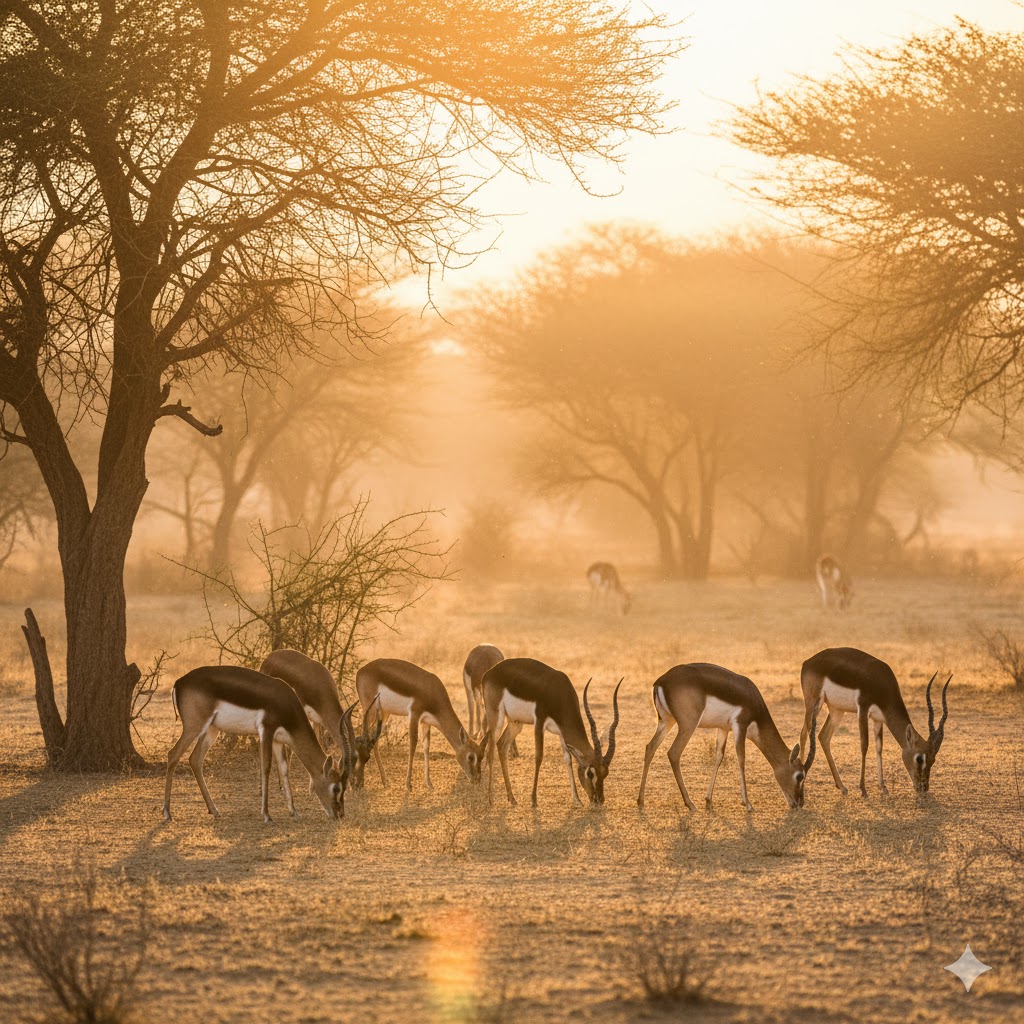
4.6 Bahawalpur Museum — The Chronicle of Nawabi Splendor
For travelers seeking context behind Bahawalpur’s regal identity, the Bahawalpur Museum is an essential stop. Established in 1976, the museum houses artifacts from the Indus Valley Civilization, Abbasi Nawab dynasty, and Islamic calligraphy collections.
Highlights include miniature manuscripts, coins from the Delhi Sultanate, and portraits of Bahawalpur’s Nawabs adorned in ceremonial robes. The Islamic Art Gallery and Ethnological Section showcase intricate pottery, embroidered textiles, and jewelry from rural Punjab and Cholistan.
Local Insight: The museum’s staff are known for their hospitality — ask for a guided explanation of the Bahawalpur State’s insignia and seals. Entry fee is around PKR 100.
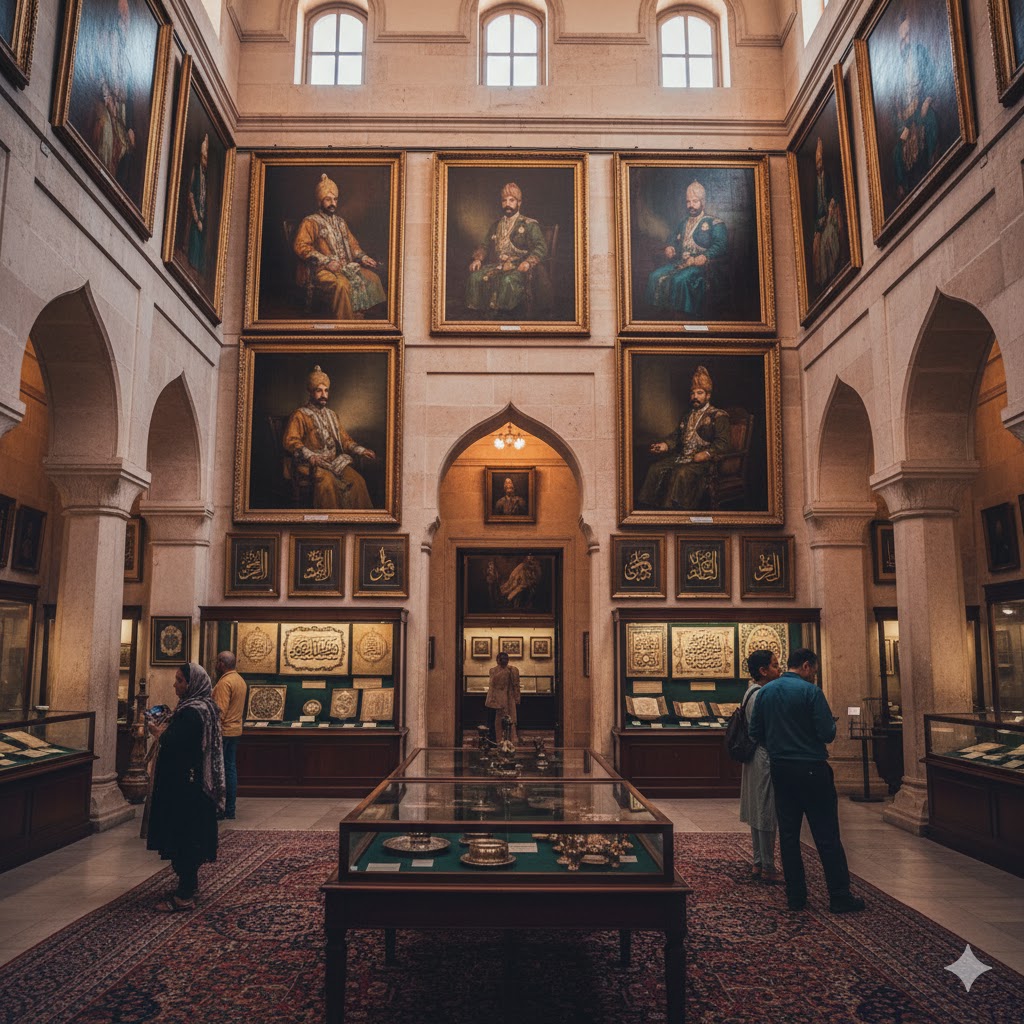
4.7 The Central Library Bahawalpur — A Royal Repository of Knowledge
Standing proudly near Farid Gate, the Central Library Bahawalpur was inaugurated in 1924 by Nawab Sir Sadiq Muhammad Khan V. Its Indo-Saracenic façade, tall arched windows, and white domes echo the grandeur of colonial architecture.
The library holds over 100,000 books, including rare Persian manuscripts and early Urdu journals. Its reading hall, with high ceilings and old wooden shelves, exudes vintage charm — a haven for history lovers and researchers.
Traveler’s Tip: Photography inside may require permission. Best time to visit is early morning when sunlight filters through the stained-glass windows.
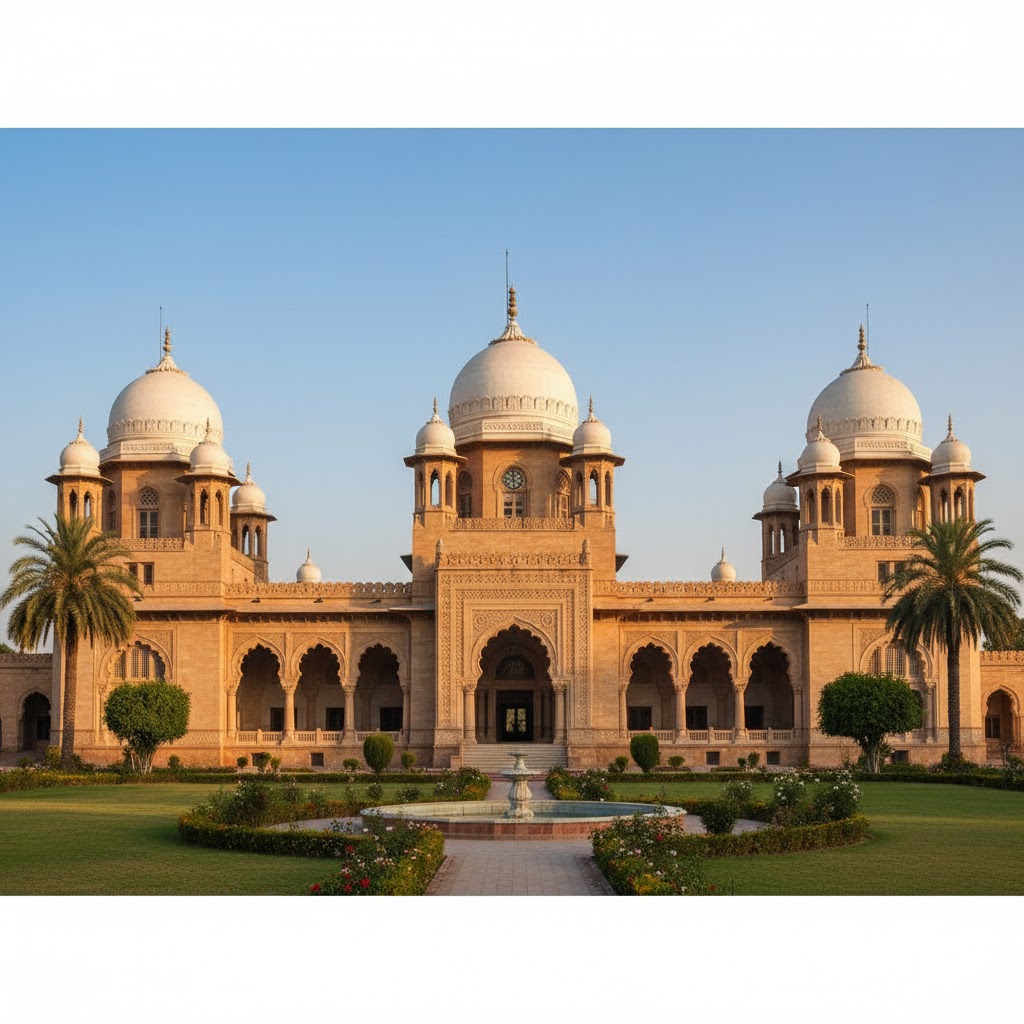
4.8 Sufi Shrines of Bahawalpur — The City’s Spiritual Core
Bahawalpur’s grandeur extends beyond its palaces to the shrines of revered saints that shape the city’s spiritual fabric. The Shrine of Hazrat Abbas Shah, Hazrat Mehboob Subhani, and Hazrat Channan Pir (located in Cholistan) are among the most visited.
Each year, devotees gather for urs celebrations filled with qawwali, prayers, and langar. The Channan Pir Mela, held in February–March, attracts pilgrims and travelers who witness centuries-old Sufi traditions thriving amidst the desert.
Traveler’s Tip: Always carry a scarf for head covering; women can comfortably visit these shrines during daylight hours.
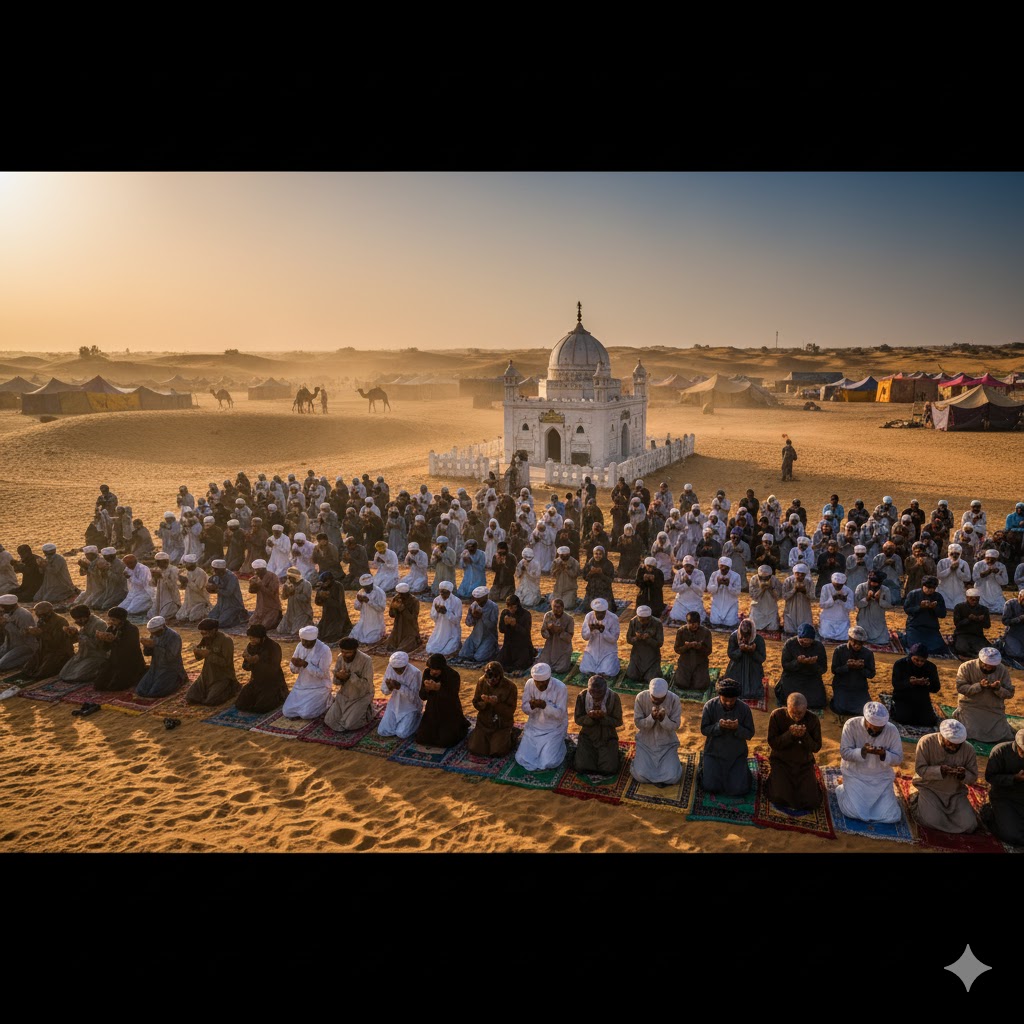
4.9 Bahawalpur’s Vibrant Bazaars — Where Heritage Meets Handicraft
The city’s bazaars — Shahi Bazaar, Machli Bazaar, and Farid Gate Market — pulse with color and craftsmanship. Artisans sell camel leather goods, blue pottery, Ajrak shawls, and hand-embroidered cholistan textiles.
The royal heritage reflects in Bahawalpur’s traditional jewelry and khussa (embroidered shoes), often made using age-old techniques passed down through generations.
Local Tip: Bargaining is part of the culture but do so politely. Always purchase from artisans who craft by hand, not from resellers.
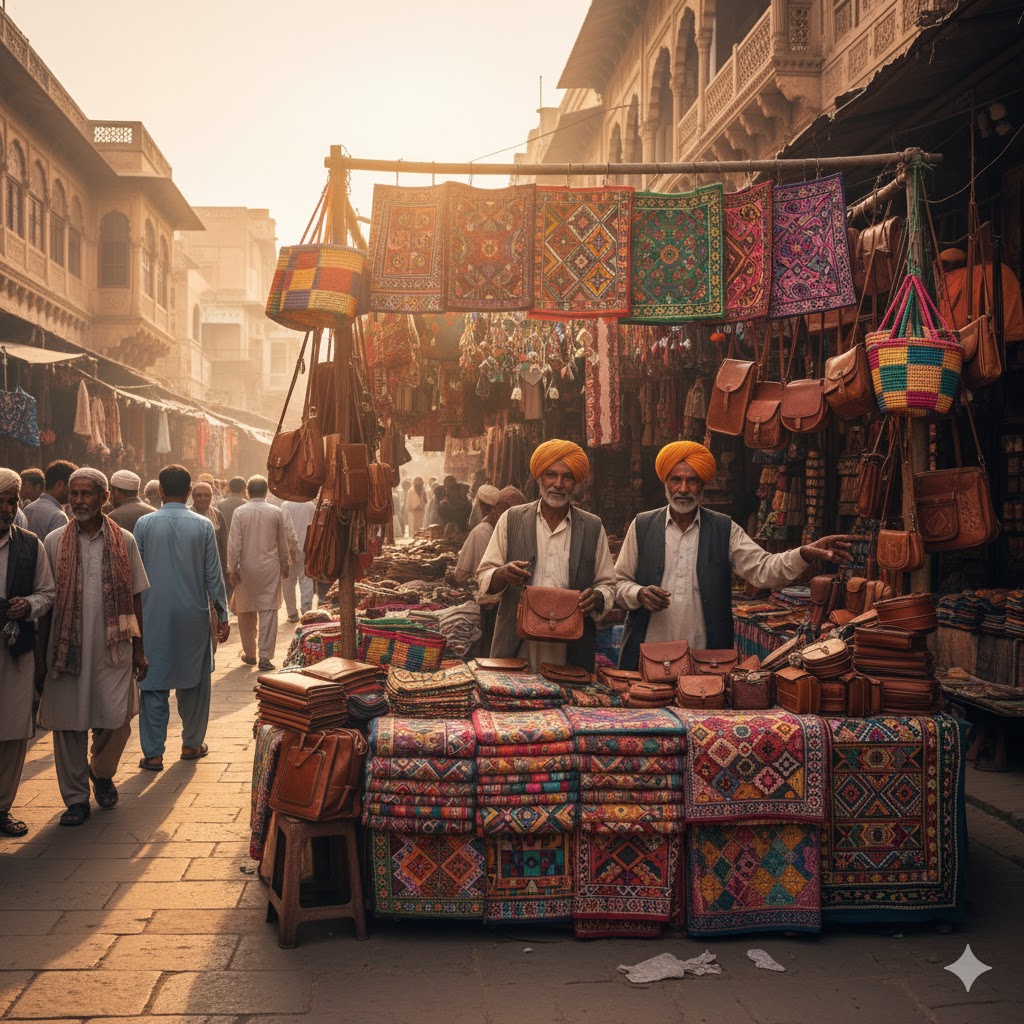
4.10 Festivals & Events — The Spirit of Bahawalpur
Bahawalpur hosts some of Pakistan’s most dynamic annual festivals that celebrate its cultural and natural beauty.
• Cholistan Jeep Rally (February)
A thrilling off-road race across the desert organized by the TDCP (Tourism Development Corporation of Punjab). It attracts racers from all over Pakistan and international drivers.
• Channan Pir Mela (March)
A spiritual carnival near Yazman town, combining devotion, folk music, and traditional food — one of Punjab’s most inclusive festivals.
• Bahawalpur Literary Festival (November)
Celebrating literature, music, and art, this growing event brings together poets, historians, and travelers to discuss regional culture.

4.11 Bahawalpur Cuisine — Nawabi Flavors Reimagined
The city’s culinary scene reflects its royal past — rich, flavorful, and deeply satisfying. Dishes like Nawabi biryani, mutton korma, and sohan halwa dominate local dining tables.
Visit Café Deewan, Four Seasons Restaurant, or Usmania Tandoor for authentic local dishes. Street vendors near Farid Gate serve the best lassi, tikka, and chana chaat for a truly local experience.
Traveler’s Tip: Don’t leave without trying Bahawalpur’s Sohan Halwa — a sweet delicacy symbolic of hospitality in southern Punjab.
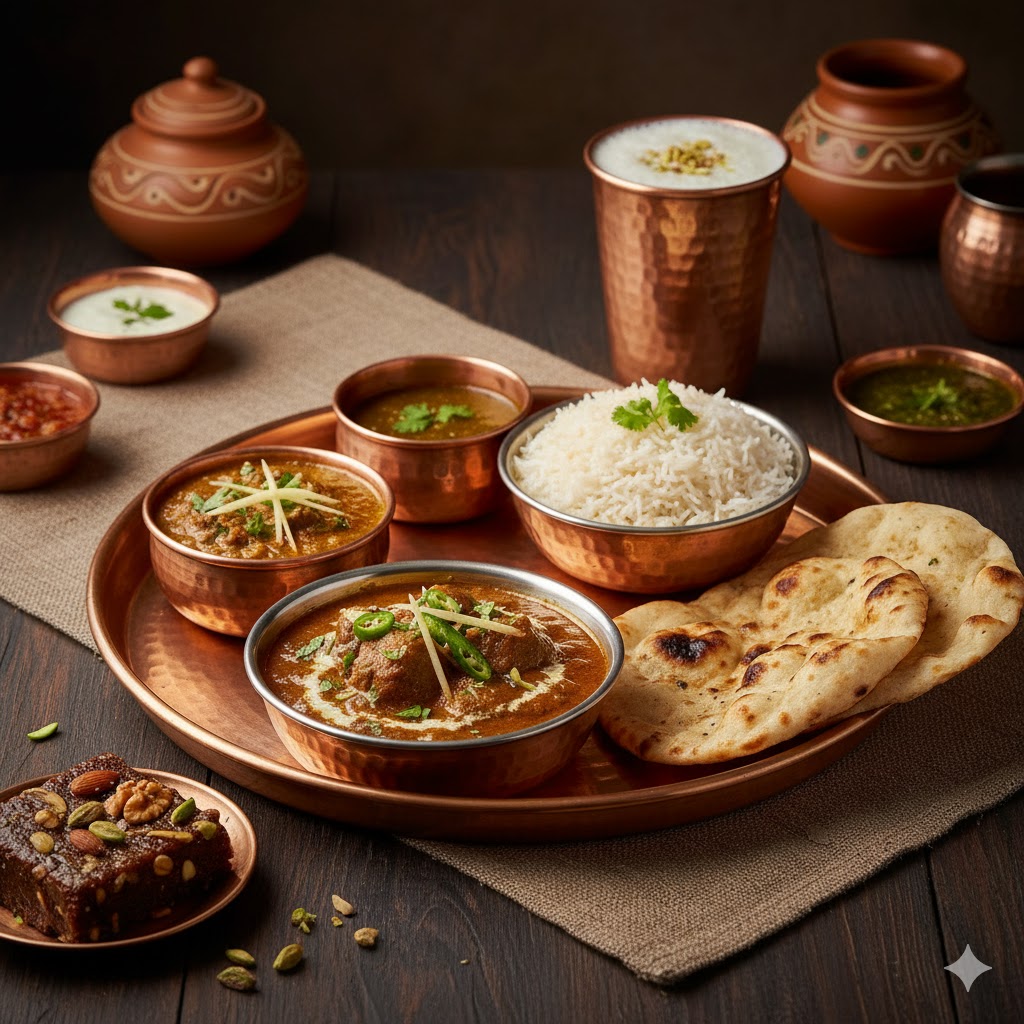
4.12 Noor Mahal — The Crown Jewel of Bahawalpur
Noor Mahal, often called the “Palace of Light,” is the most photographed landmark in Bahawalpur. Built in 1872 by Nawab Sadiq Muhammad Khan IV, the palace reflects Italian and Indo-Saracenic architectural brilliance — a symphony of marble columns, Corinthian capitals, and sprawling lawns.
With over 30 luxurious rooms, a royal banquet hall, and exquisite chandeliers imported from Belgium, Noor Mahal stands as a reminder of Bahawalpur’s opulent past. At night, its golden illumination transforms the structure into a fairytale vision.
Traveler’s Tip: Visit around sunset (5:30–6:30 PM) for magical photography. Entry fee is PKR 100; guided tours available through TDCP.
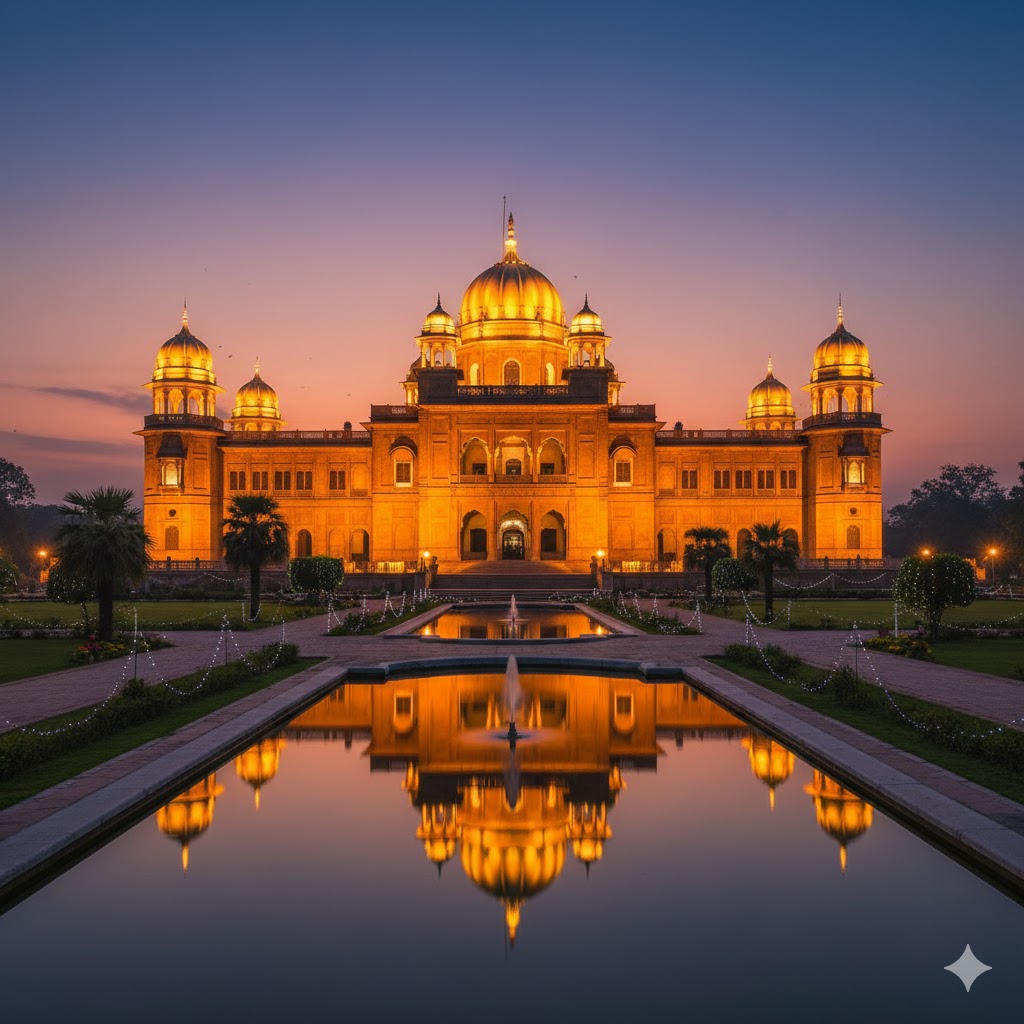
4.13 Darbar Mahal — The Scarlet Jewel of the Nawabs
Constructed in 1905, Darbar Mahal was built by Nawab Bahawal Khan V as a royal court complex. The palace features red-brick façades, intricately carved arches, and marble balconies influenced by Mughal and Corinthian aesthetics.
Now under the custody of the Pakistan Army, visitors can only admire its splendor from outside unless granted special permission. However, its exterior remains one of the most stunning architectural marvels in southern Punjab.
Local Tip: Combine your visit with Gulzar Mahal and Farid Gate for a complete architectural photography tour.
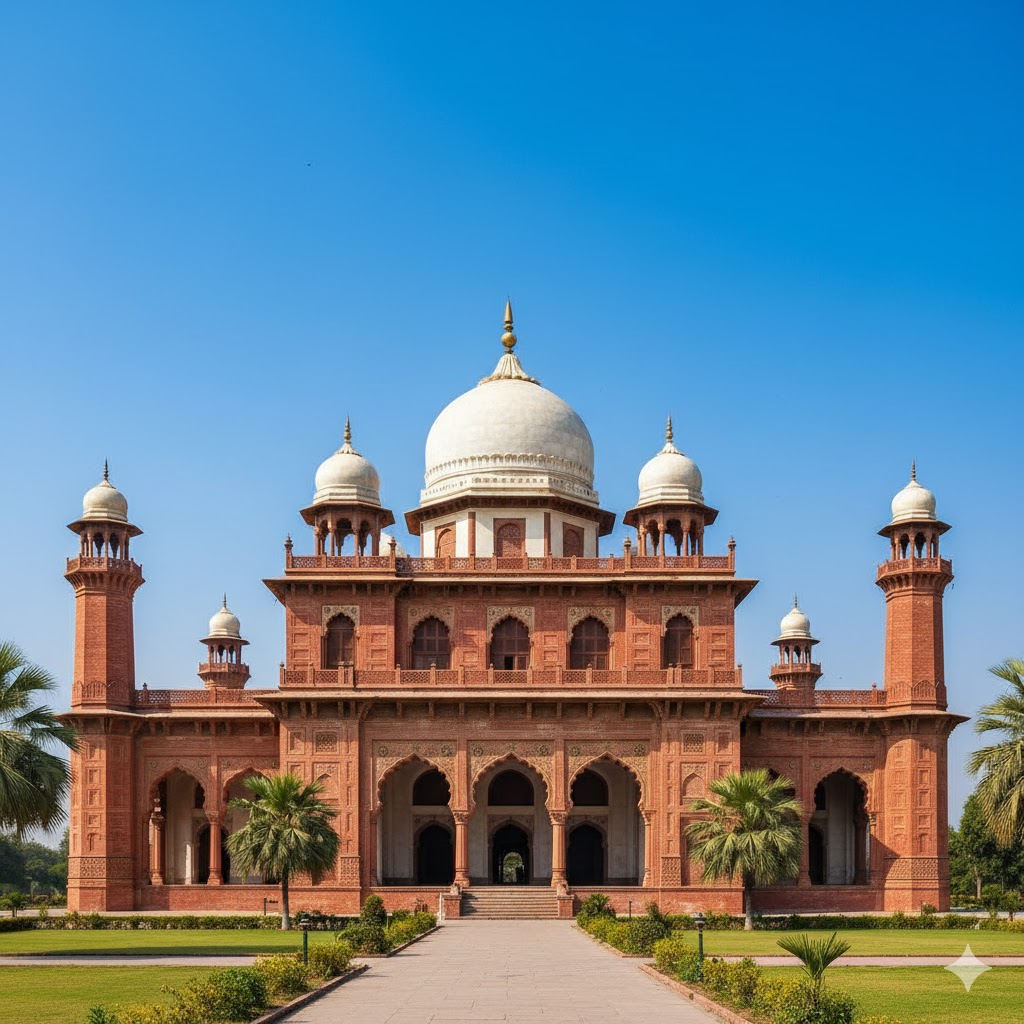
4.14 Sadiq Garh Palace — A Royal Abode Lost in Time
Once a residence of Nawab Sadiq Muhammad Khan IV, Sadiq Garh Palace in Ahmedpur East lies in quiet grandeur. Constructed in 1882, it featured 120 rooms, an Italian marble staircase, crystal chandeliers, and vast gardens that once hosted royal receptions.
Though now closed to the public, restoration efforts are underway. Travelers can still capture its majestic exterior — a poignant reminder of Bahawalpur’s regal era.
Traveler’s Tip: Seek local guidance or contact TDCP offices for updated visiting permissions before traveling.
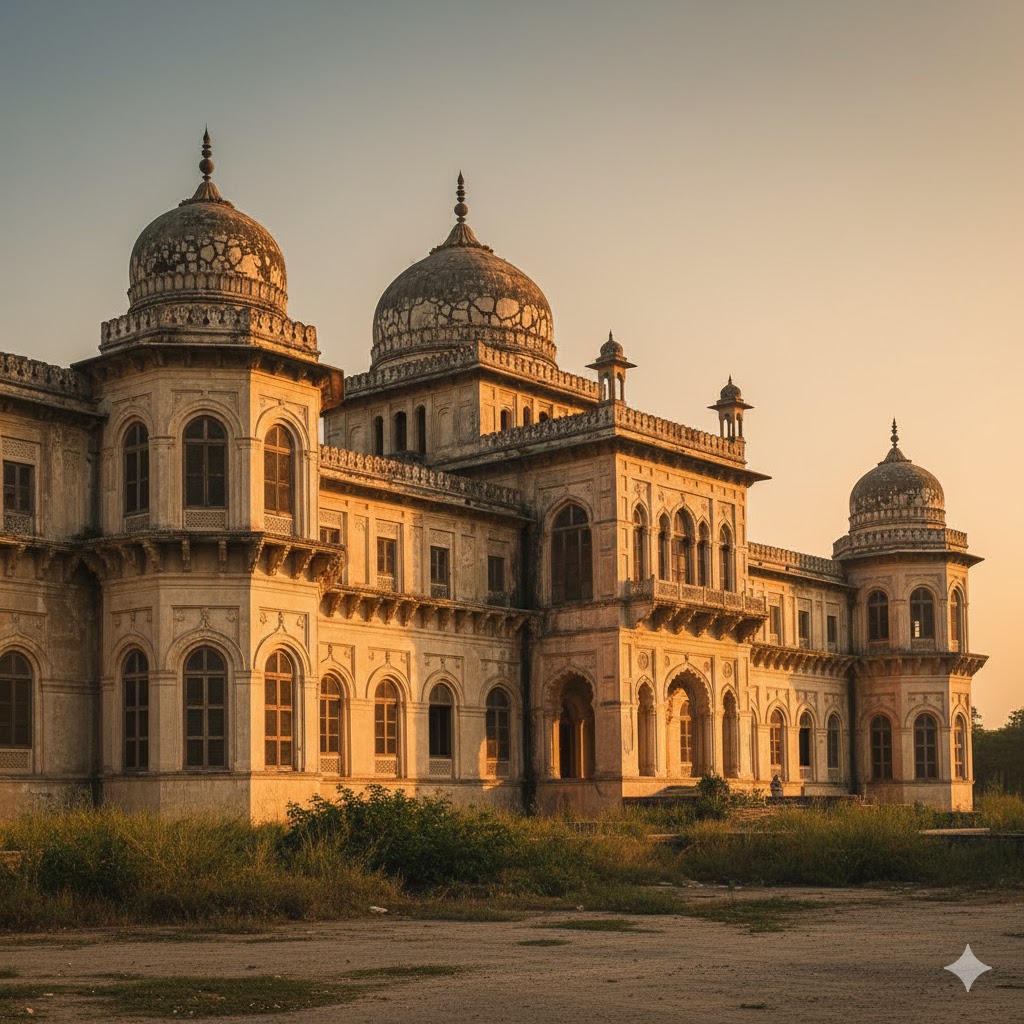
4.15 Desert Adventure — Jeep Safaris & Camping in Cholistan
For thrill-seekers, Cholistan Desert offers one of Pakistan’s most spectacular off-road experiences. Begin your jeep safari from Derawar Fort, tracing ancient caravan routes that once connected Multan to Jaisalmer.
Adventure operators offer 4×4 desert drives, camel safaris, and overnight desert camps where you can enjoy bonfires, folk performances, and stargazing.
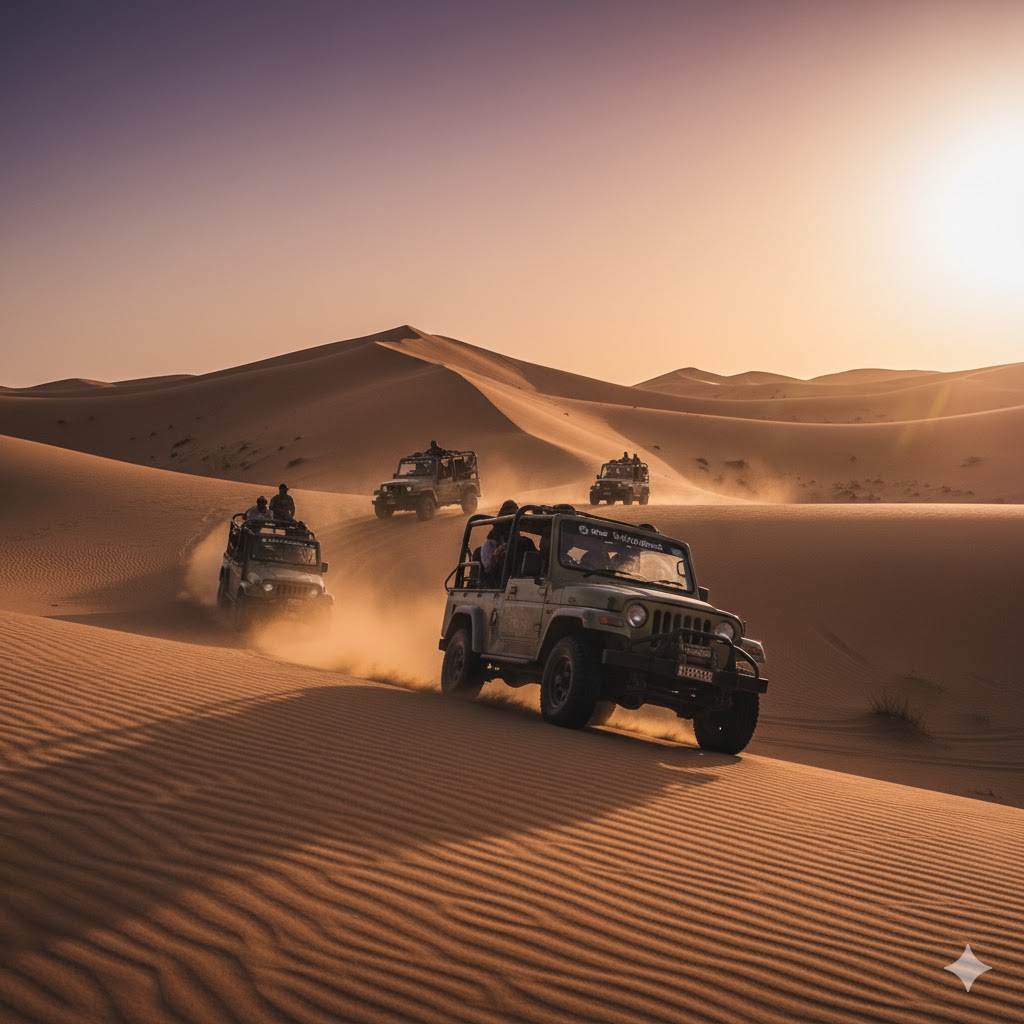
Eco-Tip: Avoid littering dunes; hire local guides from TDCP Cholistan Camp or Jeep Club Bahawalpur to support sustainable tourism.
4.16 Eco-Tourism & Wildlife Trails
Beyond the desert, Bahawalpur’s eco-tourism efforts are gaining momentum. The Lal Suhanra Safari Trail, Blackbuck Breeding Zone, and Eco-Lake Birdwatch Route promote nature-friendly travel. Visitors can spot flamingos, cranes, and pelicans during winter migrations.
Traveler’s Tip: Bring binoculars, sunscreen, and reusable water bottles. Photography enthusiasts can capture incredible birdlife from the watchtower near Patisar Lake.
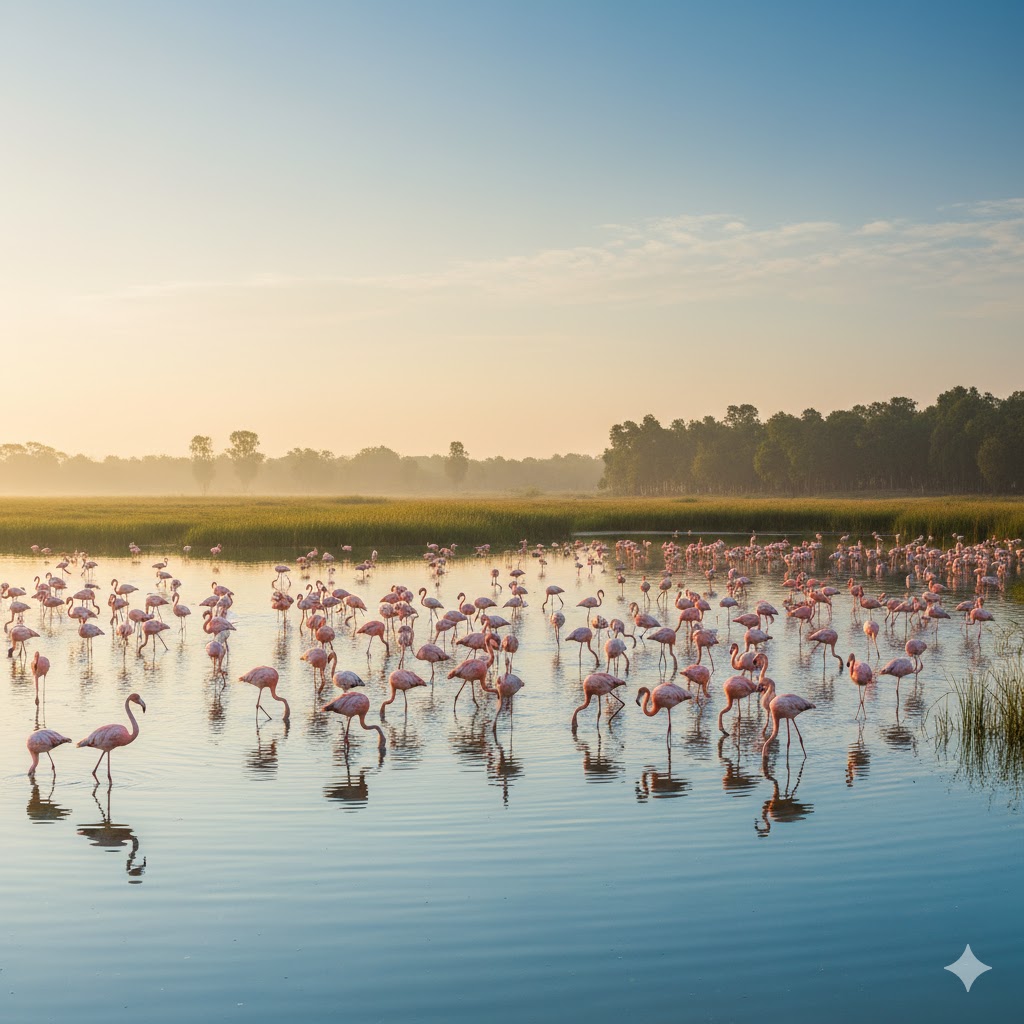
4.17 Local Experiences — Meet the Artisans of Cholistan
Venture into Derawar village or Yazman, where local artisans handcraft camel-skin lamps, multicolored rillis (patchwork quilts), and hand-embroidered khussas. These products not only represent centuries-old skills but also sustain local families.
Local Tip: Always ask permission before photographing artisans at work; a small tip or purchase is appreciated as a gesture of respect.
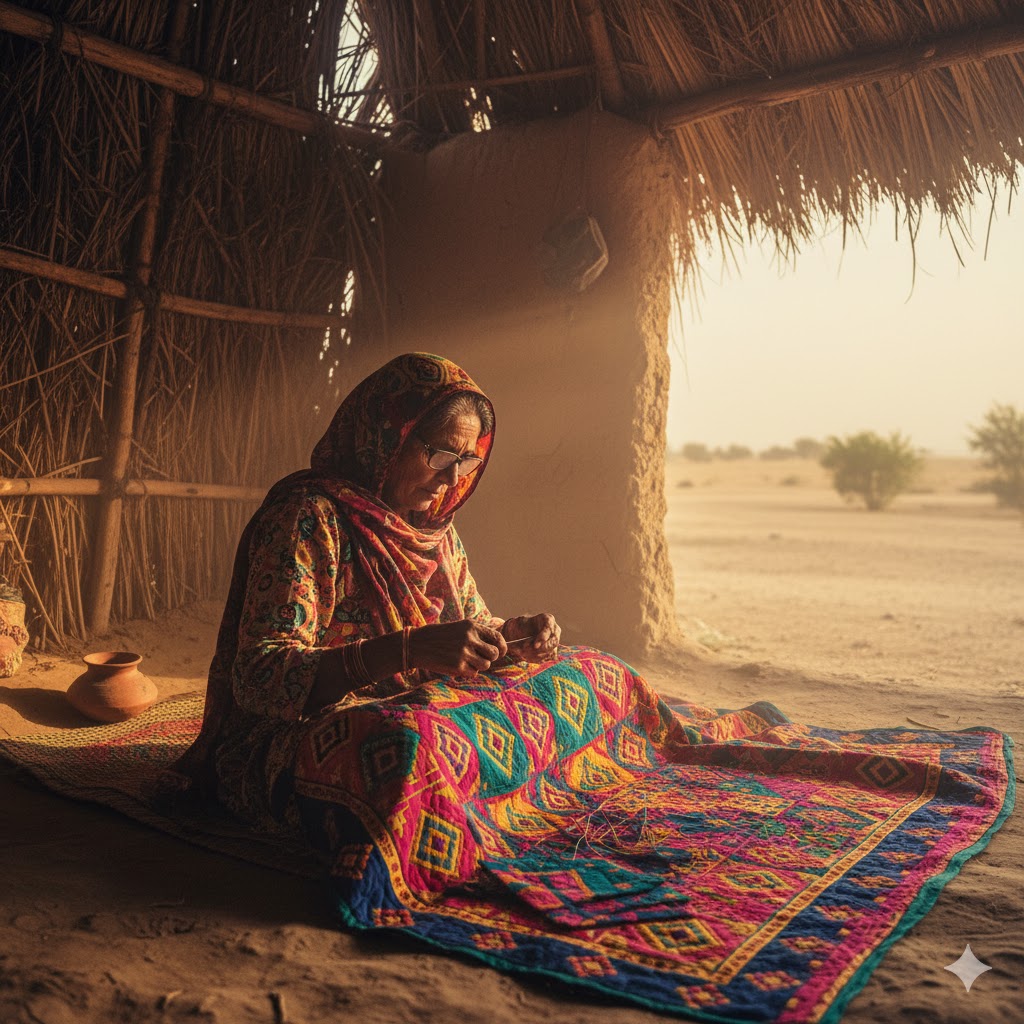
4.18 Accommodation Guide — Stay Like Royalty
Bahawalpur offers stays for every traveler, from boutique heritage hotels to luxury resorts.
- Noor Mahal Guest House: Inside the city center; elegant and peaceful.
- TDCP Motel Bahawalpur: Budget-friendly, perfect for families.
- Hotel One Bahawalpur: Offers modern amenities and excellent breakfast.
- Derawar Desert Camp: Ideal for adventure travelers seeking an authentic desert night experience.
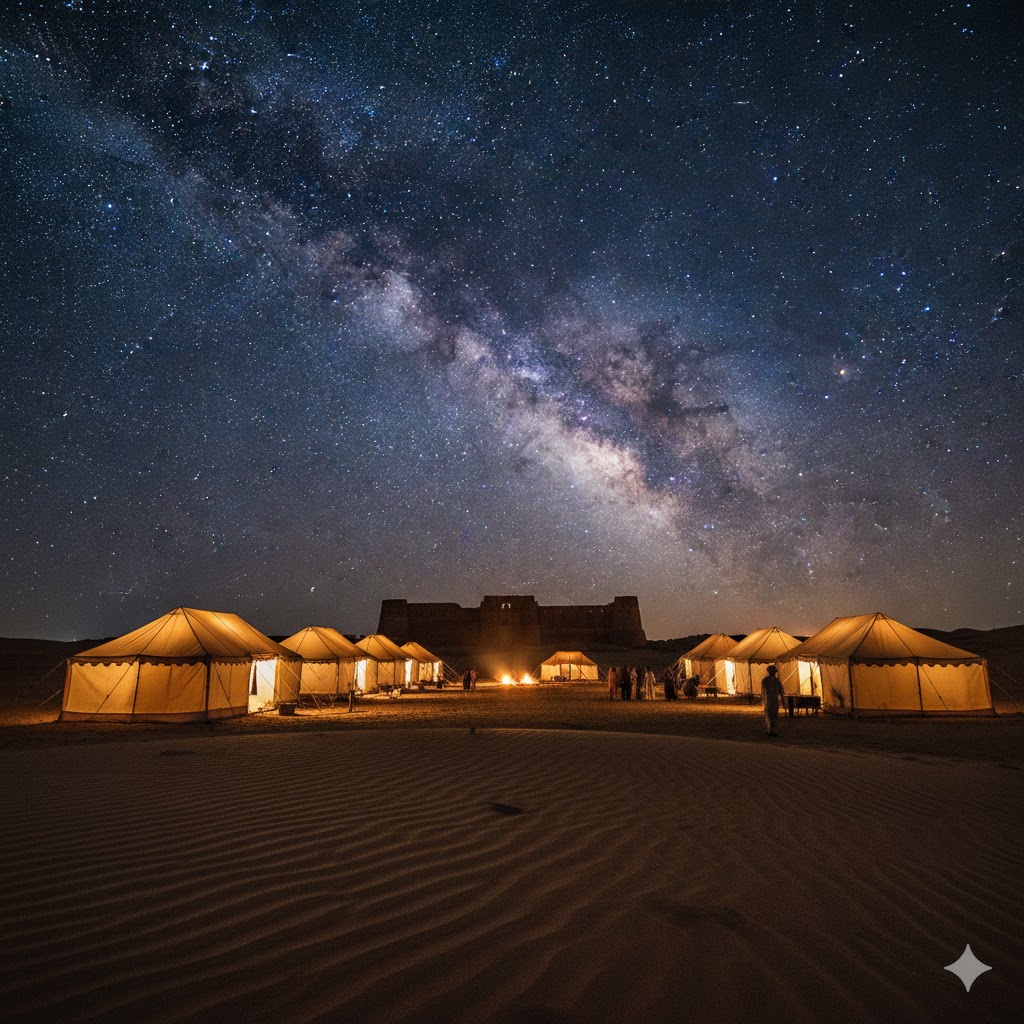
4.19 Getting There — Road, Air & Local Transport
- By Air: Daily flights from Lahore and Karachi to Bahawalpur Airport (BHV).
- By Road: 2-hour drive (180 km) from Multan, 9-hour drive (700 km) from Karachi via N-5 and M-5 Motorway.
- By Train: Pakistan Railways connects Bahawalpur to Lahore, Karachi, and Islamabad.
- Local Transport: Rickshaws, Careem, and private cabs are easily available.
4.20 Suggested Itinerary — 3 Days in Bahawalpur
Day 1: Explore Noor Mahal, Central Library, and Bahawalpur Museum
Day 2: Derawar Fort, Lal Suhanra National Park, and Cholistan Jeep Safari
Day 3: Bazaar shopping, visit Darbar Mahal, and enjoy Nawabi cuisine
4.21 Cadet College Bahawalpur — Nurturing Leaders of Tomorrow
Established in 1954 by Nawab Sadiq Muhammad Khan V, Cadet College Bahawalpur (CCB) holds the distinction of being one of Pakistan’s oldest and most respected military preparatory institutions. The college continues the Nawabi legacy of investing in youth education and leadership.
Located near the historic Ahmedpur East Road, CCB’s sprawling campus blends colonial-era architecture with modern military infrastructure. The red-brick buildings, vast parade grounds, and residential hostels reflect the discipline and elegance of Bahawalpur’s heritage.
The college offers education from 8th to 12th grade, focusing on academic excellence, physical fitness, and moral development. Many of its graduates have gone on to serve in the Pakistan Armed Forces, civil service, and top universities across the country.
Traveler’s Note: While the campus isn’t open for casual tourism, it can be admired from outside for its stunning architecture and manicured surroundings. Visitors attending academic or military ceremonies must have prior permission.
Local Tip: The Cadet College Museum, when open for visitors, showcases memorabilia from the Nawab’s era, early student uniforms, and archival photographs of royal inaugurations.
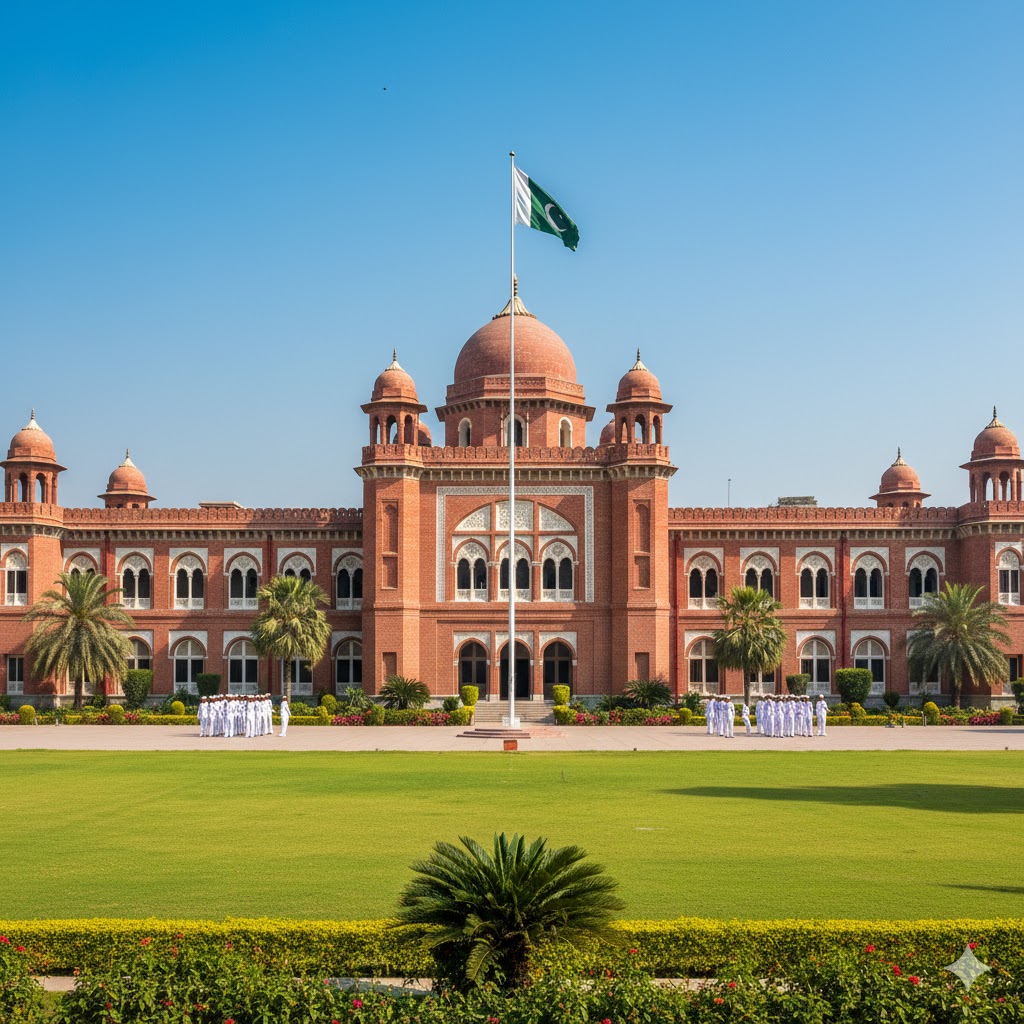
Cadet College Bahawalpur (CCB)
- Established in 1954 by the Nawab of Bahawalpur, the institution is one of Pakistan’s older cadet/military-preparatory colleges.
- Located near Ahmedpur East Road, Bahawalpur city.
- It offers residential boarding from grades 8 through 12 (or equivalent), combining academic, physical, and character development training.
- The campus architecture reflects the Nawabi legacy of Bahawalpur, with red-brick buildings, parade grounds, and formal landscaping.
- Note: While many cadet colleges publish detailed public information, I was not able to locate extensive recent public data (e.g., official website, detailed history) specifically for CCB. So you may want to contact local Directorate or TDCP for up-to-date facts if you rely on it.
- Suggested Alt Text: “Majestic red-brick architecture of Cadet College Bahawalpur with flag hoisted on parade ground under blue sky.”
📚 Other Important Education & Cultural Institutions in Bahawalpur to Include
- Sadiq Public School – A prestigious boarding/preparatory school in Bahawalpur, large campus (~451 acres) and established 1953.
- Government Sadiq Egerton College Bahawalpur – Historic college (est. 1886) named after Nawab Sadiq Muhammad Khan IV and Sir Robert Egerton; reflects the region’s legacy in higher education.
- Incorporating these helps reinforce Bahawalpur’s identity not only as a tourist destination but a centre of heritage, education and culture.
Traveler Guide — Rediscover Bahawalpur’s Timeless Grandeur
Bahawalpur, once a princely state of nawabs, today stands as one of Southern Punjab’s most underrated gems — where history whispers through marble halls and the desert hums with stories of devotion and resilience. From the majestic Noor Mahal and Derawar Fort to the vast Cholistan Desert, the city’s contrast of royal splendor and rustic simplicity offers travelers an unmatched blend of culture, adventure, and serenity.
Whether you’re an architectural enthusiast, a nature lover, or a soul-searcher tracing Sufi heritage, Bahawalpur welcomes you with open arms. Its artisans, palaces, eco-trails, and camel caravans together make this destination a soulful retreat for 2026 and beyond.
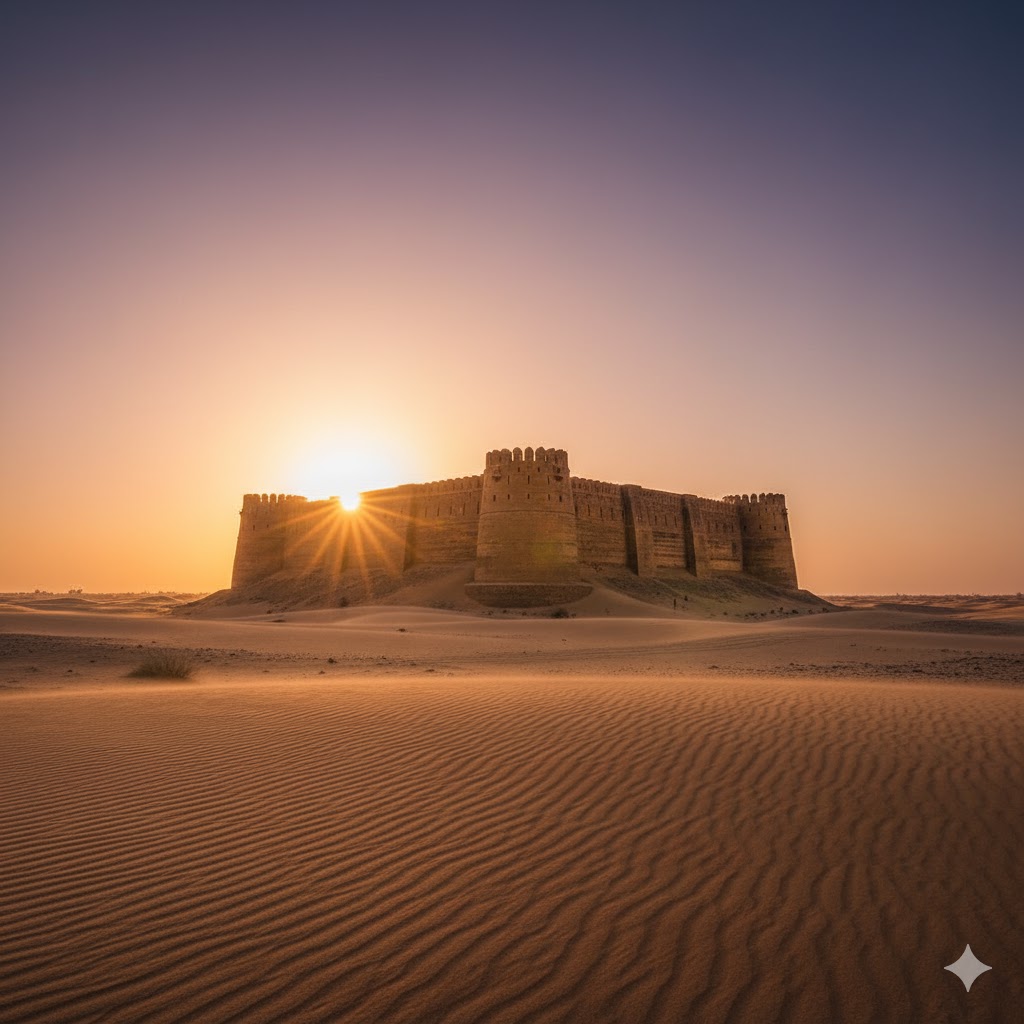
Read More:
- Southern Punjab’s Cultural Attractions (2026) — Explore other cities rich in heritage like Multan and Dera Ghazi Khan.
- Multan’s Sufi Heritage Walks (2026) — Continue your journey through Pakistan’s spiritual heartland.
Sources:
- Tourism Development Corporation of Punjab (TDCP) — Official site for tours, safaris, and hotel reservations in Bahawalpur.
- Pakistan Railways Official Portal — Train schedules, routes, and ticket bookings to Bahawalpur.
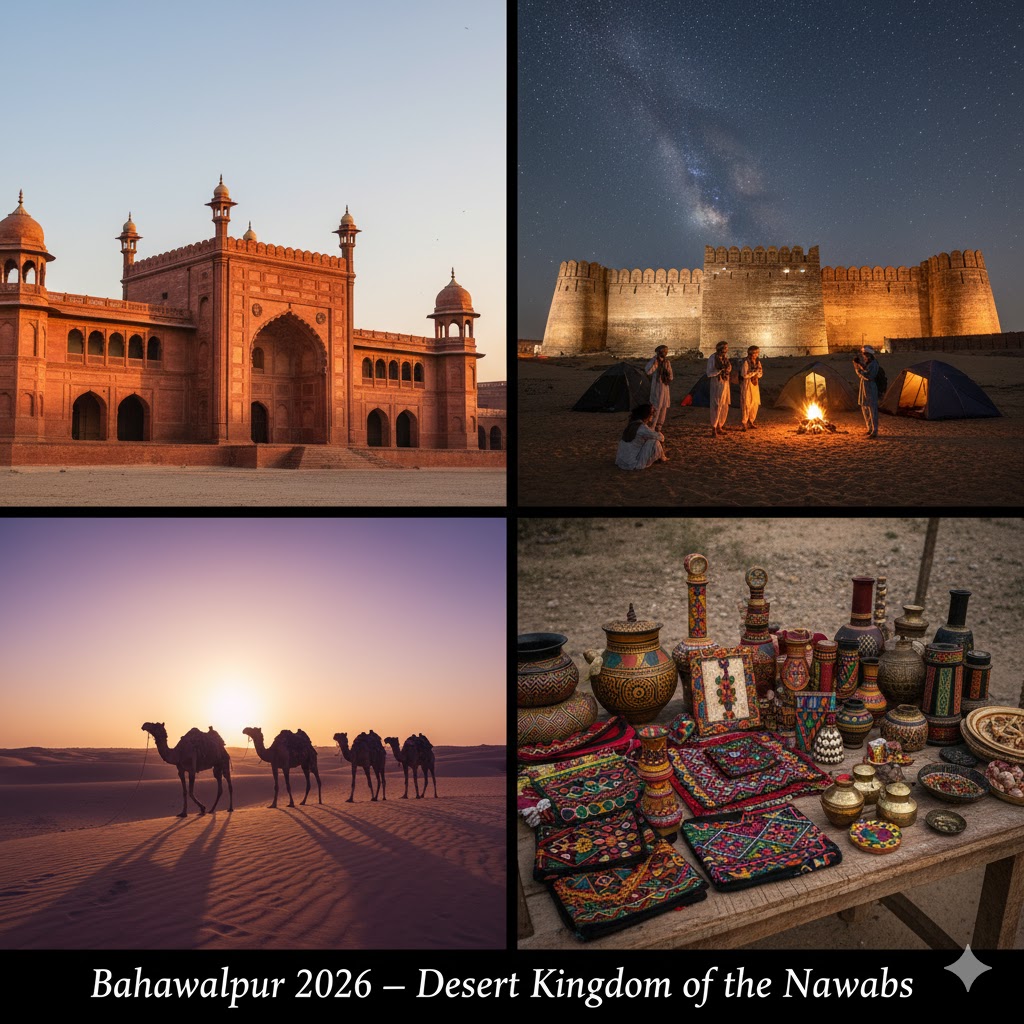
❓ 7. FAQs — Bahawalpur Travel Guide 2026
Q1. What is the best time to visit Bahawalpur?
➡️ Between November and March — pleasant weather, ideal for exploring the desert and palaces.
Q2. How far is Bahawalpur from Multan?
➡️ About 180 km — roughly a 2-hour drive via M-5 Motorway.
Q3. Can tourists visit all the palaces?
➡️ Noor Mahal is open daily for visitors. Darbar Mahal and Sadiq Garh Palace require special permissions.
Q4. What are must-buy souvenirs from Bahawalpur?
➡️ Camel-skin lamps, hand-embroidered rilli quilts, Multani blue pottery, and sohan halwa.
Q5. Is the Cholistan Jeep Rally open to visitors?
➡️ Yes, held every February, with special viewing zones and camps for tourists.
Q6. Are there eco-tourism options in Bahawalpur?
➡️ Absolutely — Lal Suhanra National Park offers safaris, birdwatching, and eco-lodging options.
Q7. Is Bahawalpur safe for solo travelers?
➡️ Yes, the city is peaceful and friendly. Always travel with licensed guides for desert areas.
Q8. What’s the local cuisine like?
➡️ Try Cholistani lamb karahi, saag with makai roti, and falooda. Street food at Farid Gate is also a must-try.
Q9. Can I visit Derawar Fort at night?
➡️ Night visits are restricted, but you can camp near the fort through TDCP-approved safari camps.
Q10. What’s the nearest airport to Bahawalpur?
➡️ Bahawalpur Airport (BHV) — connected to Lahore, Karachi, and Islamabad with daily flights.
